
Btrax Design Company > Freshtrax > A How-to on Und...
A How-to on Understanding Design Sprints
Have you ever heard of a design sprint? If you have, then you’re in the loop on an innovative way of ideating and establishing what direction to take new product ideas in. If you haven’t, fear not! Read on to understand what a design sprint is and whether or not you should run one!
Design sprints are exploding in popularity across companies of all sizes because of the immense value they can bring. There were over 400 companies from TIME to YouTube participating in the inaugural Sprint Day and Sprint Week events of 2016 alone.
Sprints were created to help people answer critical business questions rapidly. A myriad of companies such as Airbnb, Facebook, and Blue Bottle Coffee are seeing great results.
What is a Design Sprint, Really?
At its core, the design sprint is a problem-solving technique that businesses use to address challenges. However it’s much more than that. The design sprint is a five-day intensive process that push teams to tackle design, prototyping, and user testing, resulting in a high-fidelity prototype.
Where Does it Come From?
It is a technique co-founded and popularized by Jake Knapp, along with John Zeratsky and Braden Kowitz of Google Ventures. Knapp is also the author of Sprint, an influential international best-seller detailing a step-by-step breakdown of the design sprint process, and sharing insights gleaned from his many years of experience leading them.
Why is it Important?
The design sprint has been used in many companies including Quizlet, Slack, and Flatiron Health. The technique is enabling international organizations, nonprofits, and schools alike to see huge results. Sprint teams are able to focus on problem solving and pushing past big challenges through its strict time limit, in a way that normal business practices are unable to do.
How Does it Work?
Part of the success seen from running a design sprint comes from its unique structure, optimized for decision making and culminating the team’s efforts in a tested prototype.
Take a look at the rough organization of the sprint below:
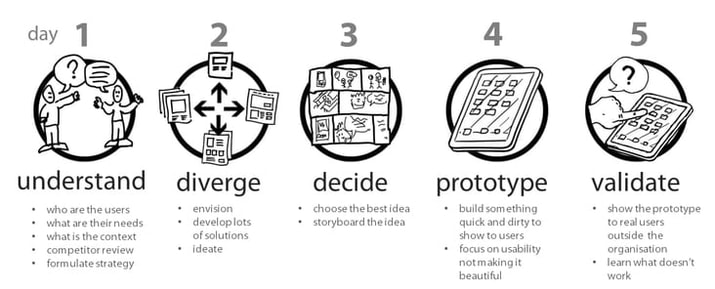
Photo by: Google Design Sprint
It’s plain to see how, through its rigorous structure and process, innovation and excellent solutions or directions can be discovered! We saw similar successes as an agency in our most recent sprint as well.
Our Experience with Sprints
We worked with a client in Japan June of this year to help them create a prototype of an app idea they had.
Pre-Sprint Research, Preparation, and Planning
Client needs differ, and we decided to hold a research phase prior to our sprint to orient and prepare our client. We found this phase was necessary for them to understand what was possible and where the limitations and competitors were.
It showed us what needed to be verified, what potential challenges there may be, and what ideas already existed in the client’s target niche, which aided greatly once the sprint was underway.
Below we will go over a general structure of how each day should be organized.
Day 1 – Monday
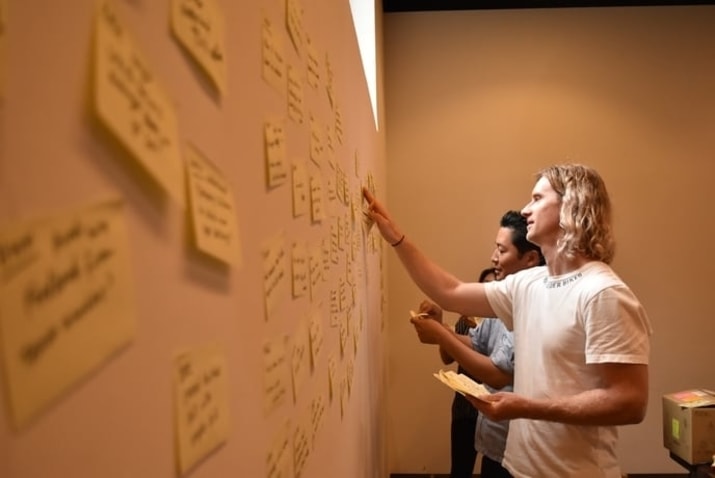
Design sprint facilitator and btrax’s Director of Design and Development Jensen Barnes as the team puts their ideas up during the sprint with our client.
Morning: A long-term goal with the team should be set through structured discussion and team roles should be assigned. One person should be the decider, and this person will have overriding power on decision-making to keep things moving if disagreement arises. Another person should be the facilitator, and their job is to keep time and manage the flow of the activities and time chunks.
Then a map of the problem should be made: this should include all the actors imagined in the solution (i.e. potential customers) and the actions they must take to succeed (i.e. the outcome).
Afternoon: Experts at the client’s company should be invited in, or those from outside the client’s organization, to share knowledge and context to the problem. Finally, a target is picked: an audacious but achievable part of the problem that’s solvable in one week.
Day 2 – Tuesday
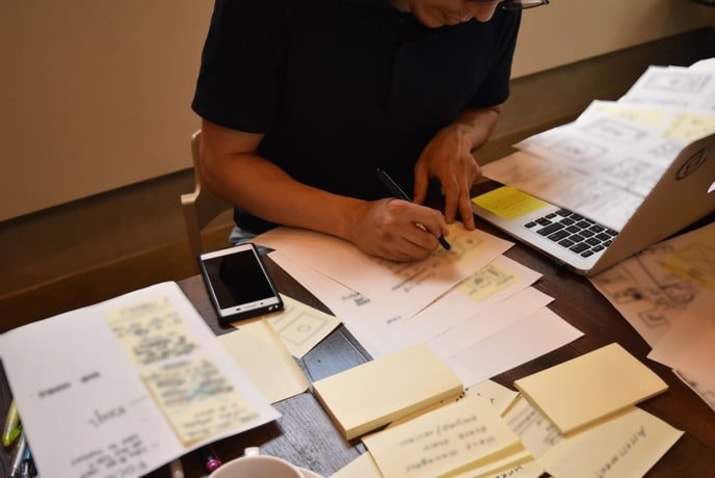
KJ, designer, developer, and project manager at btrax sketching out potential solutions.
Morning: Focused on quickly looking at demos of great solutions from various companies, and this can include the client’s.
Afternoon: People are assigned to different parts of the map to sketch it out. This is then broken down into four steps:
- Silently walking around the room to gather notes from ideas (20 min)
- Privately writing out ideas and circling the best ones (20 min)
- Creating a storyboard with eight frames and quickly sketching a variant of the best solution in each frame (8 min)
- Creating a three panel storyboard in more detail considering wording too (30-90 min)
Someone should also be designated as the recruiter of user testers, and recruitment should begin on this day. Just five user testers are needed, and it’s recommended to use Amazon gift cards or something of similar allure to get them interested.
Day 3 – Wednesday
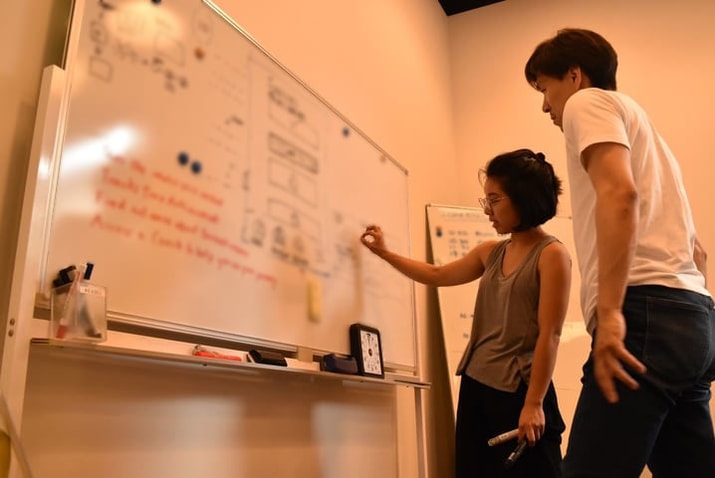
Mimi (btrax UX designer) and KJ discussing their storyboard
Morning: The emphasis is on picking out the strongest solutions from each member’s storyboards. This can be done through various means, such as pinning them all up and silently voting, doing speed critiques (i.e. spending three minutes going over the pros and cons of each storyboard), and others.
Afternoon: Once the best is decided, a more developed storyboard should be produced. It should start with an opening scene of how the potential customer would encounter the product. The whole story should be five to fifteen steps.
Day 4 – Thursday
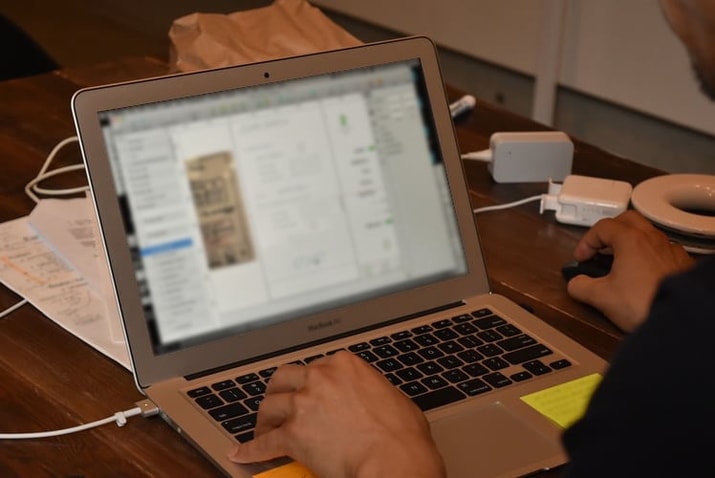
KJ busy prototyping out the solution to the client’s app challenge
Morning: Focused on prototyping, tasks should be divided up among different people and should be getting underway. This day should utilize tools that are optimized for speed and flexibility, not quality and perfection.
Afternoon: Devoted to continuing to churn out the prototype. Someone who can bring together all the disparate parts should be designated. A trial run should be done in the late afternoon. The prototype should be tried thoroughly, finalizing the features along the way.
The interview script should be completed throughout the day, and Amazon gift cards for the interviewees purchased.
Day 5 – Friday

Carrying out the user interviews.
This is the user testing day. The setup of the rooms is as follows:
- Room one is for the team to observe the interview from (using video equipment set up in room two).
- Room two is the interview room, where the interviewer and user carry out the interview.
It’s more than a user test though, which is why I use the term ‘interview’. The user should be encouraged to explore the prototype’s features to entice them to speak out loud about their actions. This will aid in understanding why they make the decisions they do.
At the end of the day, the emerging patterns from the interview data should be examined (yes, big usability patterns are revealed after just five user tests!), and the long-term goal reviewed. Where the team stands in terms of future directions should become clear.
The sprint should result in either an efficient failure – it was quickly determined that the solution won’t work, or a flawed success – the idea is not 100% polished and ready for mass production, but incredible, user-validated insights about next steps and potential directions were learned.
Retrospective
Reflecting on what happened after the sprint is essential. It’s important to ask what went well, and what could have gone better to determine the next steps. This is called a retrospective, and is a critical final piece to any successful design sprint.
Reflecting On Our Latest Sprint
Through the design sprint we ran with our client, we were able to solidify a clean and understandable prototype. We were able to pick an urgent business problem and work through one hypothesis via the sprint process, thereby efficiently collaborating and learning along the way. This is another one of the huge benefits of sprints.
Beyond adherence to the above structure, there are a number of other key areas to consider to ensure an optimal design sprint.
Timing
Each stage of a design sprint is run on a tight schedule. Sometimes the team must share information and ideas in blocks of just 15-30 minutes! You might be wondering if operating under such a tight schedule can make participants freeze up. While freezing up is not encouraged, it actually helps determine where the team’s weaknesses are, and overcoming these weaknesses is another part of the usefulness of the design sprint.
You’ll also notice that in order to contribute the most in the limited timeframe, members will ask what the most important information is, what the best possible idea is, and prioritize. They’ll make choices quickly and intuitively, and naturally operate like a well-oiled machine.
Working together with clients, btrax provides the direction which stimulates the confidence to make bold decisions within the tight constraints of sprints.
Team Composition
The team’s composition is important in a sprint. Think about it: five days solving big problems full-time, with a small team of key people. Who is included is crucial.
Rather than having just designers or engineers or others who are seemingly indispensable to the sprint and the problem you’re tackling, it is absolutely essential to have diverse representation.
The CEO shouldn’t always be in a sprint, just as customer support representatives who deal with pain points all day cannot be overlooked. When this happens, the sprint will bring about common knowledge within an organization, promote equality across different levels of employees, and even ease political tensions!
Individuals Ideate, But Avoid Groupthink
Design sprints utilize ideas thought up separately by individuals on the team. The ideas go up on a board or other surface where people place stickers on them to vote on the best ones. This promotes a chance for many ideas to come to light allowing the best to progress forward. But the Decider can ultimately choose to follow the judgment of the group or take them down a different path entirely. This helps avoid groupthink, the phenomenon where individuals in a group will shy away from challenging the status quo, oftentimes to the detriment of that group.
Full Duration Commitment
Full commitment is essential. This means no digital devices during the 5 day period, setting up automatic email replies and being unavailable for all your other meetings and work engagements. This is part of setting the appropriate environment for allowing innovation to flow forth! By doing this you can concentrate on the sprint itself and not get distracted by other commitments or notifications.
In our everyday working life we have many projects going on all at once, conversations with co-workers, thereby getting distracted often. This means that it can be very hard to focus on just one thing. But when you are in a sprint, everyone’s pushing their boundaries because of the constraints baked into its structure.
This promotes progress, and resolution to complex problems, and has the potential to fully utilize your team’s abilities. Everyone’s relationships have the potential to be strengthened as well.
Ideas Don’t Start From Zero and That’s OK
One last surprising thing about the design sprint is that the ideas that come from it could be completely new in the ideal situation, but more often they are remixed and improved versions of existing solutions, and that’s fine!
We all want to create new things and be the source of innovation, so it’s natural to feel hesitant gathering existing ideas and feeling instead the urge to start from scratch. Even Knapp himself stated he has felt this urge before and wondered if innovation can really come from others’ ideas, and the answer is yes, they most certainly can.
When Not to Sprint
Design sprints are amazing, no doubt about that! They are not the only way to solve problems though. There are several circumstances in which a design sprint may not be the best choice. You’ll want to make sure that a sprint is the right approach to the problem you’re trying to solve.
- Do you have a problem to solve? You want to make sure that you have a problem defined that you want to solve through a sprint. And you want to make sure that that problem, if not solved, is medium- to high-impact (i.e. the impact of failure on that problem is medium/high).
- Do you lack information to inform the solution? You need context and content going in, which is why we suggested a research phase prior to our last sprint in Tokyo. Ideally you want more context behind the problem and solution.
- Is it a product design problem? The design sprint is primarily used for developing a product prototype. You’ll want to reconsider your potential approaches if you’re considering it for developing a service.
- Can you really build a prototype that feels real enough in a single day? The schedule is to prototype in just one day, so you have to really think hard about whether you have the time, resources, and chosen solution that you and your team are capable of prototyping to a degree of quality where it feels like a believable product.
Conclusion
All that said, the design sprint really is an incredible process. We just wanted to stress the importance of applying it to the right situation to get the most potential out of it.
Design sprints emphasize prototyping and user testing more heavily than the user empathy process of design thinking. If what you want to accomplish is clearly defined, and you want your team to share ideas efficiently and start trying them right away, holding a sprint may be just what you need!
btrax, Inc. now offers design sprints to clients to meet their business needs. So if you are interested in utilizing this innovative method to approaching your company’s next big challenge, please get in touch with us!







